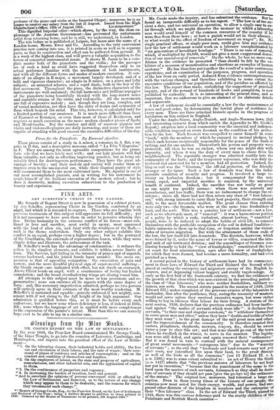FINE ARTS.
ARY SCHEFFEE'S CHRIST IN THE GARDEN.
Mr. Grundy of Regent Street is now in possession of a cabinet picture, by Ary Scheffer, representing Christ in the Garden, comforted by an angel, and which it is intended to engrave. Those who are familiar with previous treatments of this subject will appreciate its full difficulty; yet it- is not necessary to have seen them in order to perceive wherein this lies. Divine humanity in the extrema conflict of its forces—most sub- limed in love and sacrifice, most awful in agony, most oppressed with the load of alien sin, and faint with the weakness of the flesh,— such is the theme undertaken. Only one other subject exhibits this conflict in an equal, perhaps even a higher degree ; but in the portrayal of the Crucifixion, the externals of representation lessen, while they more clearly define and illustrate, the arduousness of the task.
M. Scheffer's work has the advantage of condensation : it reduces the action to its simplest elements, and exhibits it within severe limits of form. The Saviour, half failing in the intensity of prayer and of anguish, swoons backward, and his joined hands lapse asunder. The main ex- pression is that of appealing resignation: the emaciation of pain and sorrow, and the more dreadful physical' sign of super-mortal suffering— the bloody sweat—are indicated with effect, but not dwelt on overmuch. Above Christ bends an angel, with a countenance of loving but hushed consolation ; and the broad overshadowing wings are closing round him.
All attempts in this subject must be more or less proximate and re- presentative ; none can embrace all its aspects with the same degree of force: and, this necessary imperfection admitted, perhaps no two persons will entirely agree in their estimate of the most worthy rendering. M. &heifer's is sustained and equable—gravely enforced if not mighty, con- sonant with if not rising to the full height of its high argument Our admiration is qualified before this, as it must be before every such endeavour; but we know none where deficiency is less if indeed so little, frit ; none where the language of art is applied with more completeness to-the expression of. the painter's intent Mire than this we can scarcely hope ever to be able to say in a similar case.


























 Previous page
Previous page